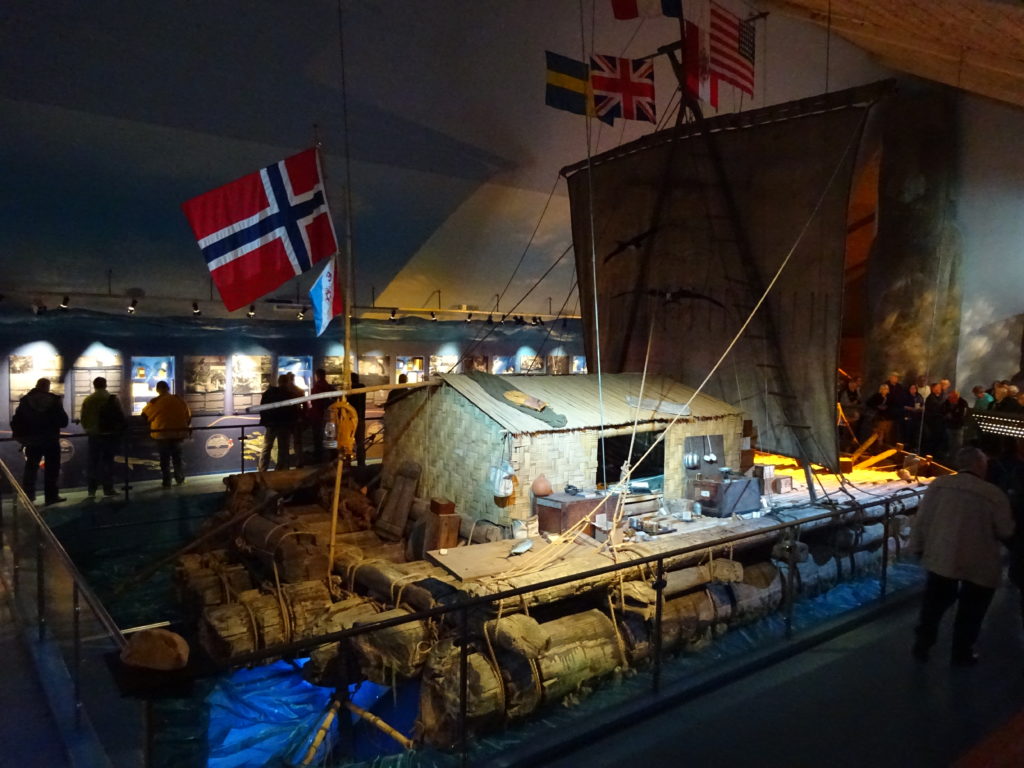 Today marks the fourth anniversary of resigning my consulting job to pursue a career science traveling. Recently I caught up with a former colleague who still works at the old firm. We hadn’t spoken in a long time so she asked me whether I had any regrets about my decision. Without a moment’s hesitation, I replied: “No regrets whatsoever.” I left with my eyes facing forward and have never once looked back on that former life.
Today marks the fourth anniversary of resigning my consulting job to pursue a career science traveling. Recently I caught up with a former colleague who still works at the old firm. We hadn’t spoken in a long time so she asked me whether I had any regrets about my decision. Without a moment’s hesitation, I replied: “No regrets whatsoever.” I left with my eyes facing forward and have never once looked back on that former life.
My new life has given me plenty to behold, including more time to travel and write.
I generally add a few new countries to my list each year. This year had fewer trips but farther destinations. I was in Seoul, South Korea during the election of a new president (to replace the one impeached and indicted), all while North Korea was haphazardly tossing around missiles. Then on to Beijing, China, which was hosting over 30 world leaders (including Vladimir Putin) for the One Belt One Road Summit. Soon I’ll be in roaming around Australia and New Zealand. The 12-hour drive to and from New England squeezed in between these two exotic locations seems tame in comparison. Another New England trip and Gettysburg are likely in the fall.
Writing has included the release of my newest book, Lincoln: The Man Who Saved America. This is my third book with Fall River Press, all now in Barnes and Noble stores. I also have two e-books available on Amazon.com (see links at end). My first book, Tesla: The Wizard of Electricity, is going into its 8th printing this fall and has been translated into several foreign languages. Edison: The Inventor of the Modern World is still in stores and may also get a new printing soon.
Meanwhile, I’m working on two new books – one on a specific area of Abraham Lincoln’s interests, and the other a travel memoir (like Paul Theroux or Bill Bryson). By January I might have a third book in progress.
My former colleague also asked a second question: do I get to read a lot? In fact, that has been one of the unanticipated benefits. I’ve increased the number of books read from maybe 50 to over 100 books per year, and broadened my reading interests considerably. Traveling helps. While I don’t read much while I’m on the ground (where my time is spent exploring), the long flights and airport time are ideal for finishing off the latest novel or taking notes on various science, Lincoln, or biography books.
I also have time to do research. I spend some time at the Library of Congress and National Archives, plus make ample use of their online collections and other electronic resources. With nearly 1200 Lincoln books in my own home library, there is no shortage of background material. The travel itself is also research. I regularly incorporate in my books the knowledge gained while traveling, and future books will involve more travel-related topics.
This past several years I’ve been actively involved with the Lincoln Group of DC. As the Vice President of Programs I schedule speakers for our monthly dinner meetings and join the Board in planning – and participating in – a wide variety of other events. Next year I’ll, well, it’s still to be determined what I’ll be doing next year, but likely I’ll still be deeply involved in Abraham Lincoln.
So what will happen in 2018? My tentative plans include considerably more travel to places I’ve never been, including (I hope) to my 6th continent and beyond my 50th country. My writing goal is to finish the Lincoln science book so that it will be in stores no later than early 2019. I’m also piecing together a travel memoir tentatively titled Patagonia Summer that will combine travel, history, and science. The third possible book will likely be a compendium with my Lincoln colleagues. There is still some uncertainty in these plans as experience has taught me that “the best laid plans” often change dramatically.
One thing is for sure. No regrets whatsoever.
See my previous “Reflections” for 2014, 2015, 2016. I’ll likely do a final “reflections” next year on my fifth anniversary, after which I’ll skip to five or ten year reports. Who knows? Maybe I’ll be too famous to write by then. 🙂
[Photo is at Kotor, Montenegro]
David J. Kent is an avid science traveler and the author of Lincoln: The Man Who Saved America, now available. His previous books include Tesla: The Wizard of Electricity and Edison: The Inventor of the Modern World (both Fall River Press). He has also written two e-books: Nikola Tesla: Renewable Energy Ahead of Its Time and Abraham Lincoln and Nikola Tesla: Connected by Fate.
Check out my Goodreads author page. While you’re at it, “Like” my Facebook author page for more updates!
Follow me by subscribing by email on the home page. Share with your friends using the buttons below.



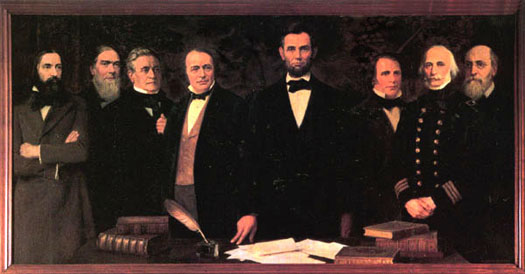
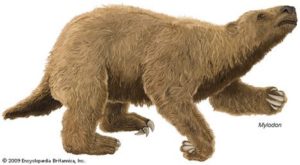 I’m currently working on a travel memoir of a recent trip to Patagonia. Our first stop was Buenos Aires, where we toured the opera house, visited the cemetery (trust me, it’s the thing to do), and dreamed about Darwin and the giant ground sloths.
I’m currently working on a travel memoir of a recent trip to Patagonia. Our first stop was Buenos Aires, where we toured the opera house, visited the cemetery (trust me, it’s the thing to do), and dreamed about Darwin and the giant ground sloths.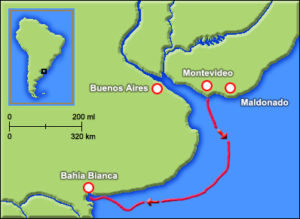 It was also in Punta Alta that Darwin made one of his biggest scientific discoveries. Ranging about the landscape on horseback, sleeping in the open with guachos or staying in haciendas with local ranchers, Darwin stumbled upon the fossilized bones of, well, something. One specimen was “the head of some large animal, embedded in soft rock.” He thought it might be similar to a rhinoceros. It took a second visit several months later – FitzRoy and his crews were busy mapping up and down the coastline – to realize he had discovered a large number of large mammal fossils not previously known from previous scientific expeditions to Europe, Asia, or Africa. In all he found nine different types of “great quadrupeds.”
It was also in Punta Alta that Darwin made one of his biggest scientific discoveries. Ranging about the landscape on horseback, sleeping in the open with guachos or staying in haciendas with local ranchers, Darwin stumbled upon the fossilized bones of, well, something. One specimen was “the head of some large animal, embedded in soft rock.” He thought it might be similar to a rhinoceros. It took a second visit several months later – FitzRoy and his crews were busy mapping up and down the coastline – to realize he had discovered a large number of large mammal fossils not previously known from previous scientific expeditions to Europe, Asia, or Africa. In all he found nine different types of “great quadrupeds.”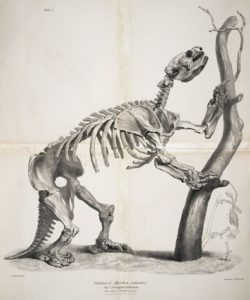 Here is where the plot thickens. While Cuvier was working up his paper describing and naming Megatherium, workers in what is now West Virginia dug up some old bones and sent them to Virginia’s biggest paleontological expert, who just happened to be Vice President of the United States, Thomas Jefferson. Jefferson named these new bones Megalonyx jeffersonii, meaning “giant claw” (the jeffersonii species name is an affectation that many discoverers take when naming their new species). These too turned out to be giant ground sloths. Meanwhile, Darwin was digging up even more sloth species. Many of these ended up in the Museo Municipal de Ciencias Naturales “Carlos Darwin,” set up in Punta Alta by modern day Argentinian geologist Teresa Manera.
Here is where the plot thickens. While Cuvier was working up his paper describing and naming Megatherium, workers in what is now West Virginia dug up some old bones and sent them to Virginia’s biggest paleontological expert, who just happened to be Vice President of the United States, Thomas Jefferson. Jefferson named these new bones Megalonyx jeffersonii, meaning “giant claw” (the jeffersonii species name is an affectation that many discoverers take when naming their new species). These too turned out to be giant ground sloths. Meanwhile, Darwin was digging up even more sloth species. Many of these ended up in the Museo Municipal de Ciencias Naturales “Carlos Darwin,” set up in Punta Alta by modern day Argentinian geologist Teresa Manera. Nikola Tesla was an eccentric genius that was born just before the U.S. Civil War and died in the middle of World War II. Since its release, my book, Tesla: The Wizard of Electricity, has been a big reason nearly 100,000 new people have learned about him. And now there is even bigger news.
Nikola Tesla was an eccentric genius that was born just before the U.S. Civil War and died in the middle of World War II. Since its release, my book, Tesla: The Wizard of Electricity, has been a big reason nearly 100,000 new people have learned about him. And now there is even bigger news.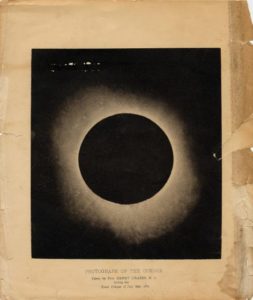 Thomas Edison invented just about everything, or at least got credit for much of it. He even was involved in a total solar eclipse in 1878. Edison had developed a tasimeter to measure infrared radiation, and he wanted to use it to measure the small changes in temperature from the sun during the eclipse.
Thomas Edison invented just about everything, or at least got credit for much of it. He even was involved in a total solar eclipse in 1878. Edison had developed a tasimeter to measure infrared radiation, and he wanted to use it to measure the small changes in temperature from the sun during the eclipse. You now have a second chance to win a copy of
You now have a second chance to win a copy of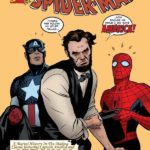 In December 1862 President Abraham Lincoln was in the midst of a Civil War, his Emancipation Proclamation was due to take effect in a few weeks, and he was struggling to maintain some sense of our national meaning. What he wrote in his message to Congress (equivalent to today’s State of the Union address) gives us lessons on how we should handle our current crisis.
In December 1862 President Abraham Lincoln was in the midst of a Civil War, his Emancipation Proclamation was due to take effect in a few weeks, and he was struggling to maintain some sense of our national meaning. What he wrote in his message to Congress (equivalent to today’s State of the Union address) gives us lessons on how we should handle our current crisis.
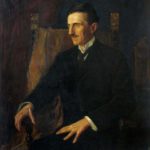 One of the most important events of Nikola Tesla’s youth relates to Tesla’s childhood cat Mačak. As Tesla writes in a letter to a friend’s daughter, at one point during a cold snowy day Tesla “felt impelled to stroke Mačak’s back.” He notes that what he saw “was a miracle which made me speechless…Mačak’s back was a sheet of light, and my hand produced a shower of crackling sparks loud enough to be heard all over the place.” Tesla’s father explained that this must be caused by electricity, like that of lightning, and this thought convinced Tesla that he wanted to pursue becoming an “electrician.”
One of the most important events of Nikola Tesla’s youth relates to Tesla’s childhood cat Mačak. As Tesla writes in a letter to a friend’s daughter, at one point during a cold snowy day Tesla “felt impelled to stroke Mačak’s back.” He notes that what he saw “was a miracle which made me speechless…Mačak’s back was a sheet of light, and my hand produced a shower of crackling sparks loud enough to be heard all over the place.” Tesla’s father explained that this must be caused by electricity, like that of lightning, and this thought convinced Tesla that he wanted to pursue becoming an “electrician.” A shocking
A shocking 